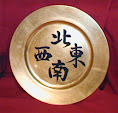It’s all very standard fare, but the layout is clear, uncluttered, and the optional rules stand clearly separated in sidebars with different colours. So kudos for the layout.
Kin
The first choice to be made is the PC’s kin (i.e., race). The choices are completely consistent with the overall vanilla fantasy look and feel of the game, except that the Chaosium roots of Dragonbane appear through the possibility of playing a Mallard (i.e., a humanoid duck). Each kin/race gives you an innate ability, which again slightly smacks of D&D rather than BRP.
Humans are nondescript. They are the last born of the young races and they can be found all over the world. Halflings live in hilly farmlands; dwarves feel a connection with rocks and fight with axes; elves are aloof and mysterious. Please kill me with the Tome of Western Fantasy Clichés.
Mallards (ah!) are a common sight in the world— so more defining a feature than in RuneQuest (where they’re only supposed to be found in the Dragon Pass area). Also, all backgrounds are open to them.
Wolfkin are the other nonstandard race. They are muscular wolf-headed humanoids and do apparently peacefully live alongside the other humanoid races.
Except for the innate ability, race doesn’t seem to affect your PC’s stats.
Profession
The second choice to be made is the PC’s profession. There are ten professions to choose from:
1. Artisan
2. Bard
3. Fighter
4. Hunter
5. Knight
6. Mage
7. Mariner
8. Merchant
9. Scholar
10. Thief
Again, these smack more of D&D classes than of BRP professions (which are really only pre-defined ways of allocating your skill points), because each profession yields a unique heroic ability. The Mage, for instance, gets to use magic, and none of the other professions may use magic (at least at character creation).
The Bard, the Fighter, the Mage and the Thief are really the equivalent of their D&D namesakes. The Artisan is a little bit of a jack-of-all-trades. The Hunter is a D&D ranger, the Knight a D&D paladin, and the Mariner a D&D thief-acrobat.
Note that I am OK with these D&D-like professions, as they give Dragonbane an OSR patina.
The only professions that really reminded me of BRP/RuneQuest are the Merchant, the equivalent to an Issaries cultist, and the Scholar, the equivalent to a Lhankoring.
Distinctive Features
The following choices to be made are the PC’s Name & Age.
Characteristics
The PC’s six characteristics (STR, CON, AGL, INT, WIL, CHA) are rolled as follows: 4D6, remove worst die, then assign in whichever order. I think this is pretty generous compared to both OSR and RQ.
I just find it odd that this isn’t the very first step, but then it is consistent with the fact that you choose your PC’s profession first.
Derived Characteristics
This step is very similar to what you would do in a BRP-derived game, with a few differences:
- Damage Bonus is STR-based only (since SIZ has been dropped), and AGL-based for ranged weapons.
- Hit Points are equal to your CON (again, because SIZ has been dropped).
Skills
This is where Dragonbane shows its BRP roots and is furthest removed from D&D-ish frp games. There are lots of skills, and by reading the examples of play it is obvious that they are at the heart of Dragonbane’s engine.
The skill base chances of the core skills are directly derived from the PC’s characteristics. In this aspect, Dragonbane is actually much more similar to Mythras than to BRP/RuneQuest.
Then there are secondary (i.e., specialised) skills in which PCs do not get a starting base chance.
Heroic Abilities
As written above, each given profession yields a heroic ability. These are quasi-magic abilities that do not function like skills but more like (Battle /Spirit) Magic spells from BRP/RuneQuest. For instance if you are a Thief you get the Backstabbing heroic ability: by spending 3 WPs, your attack cannot be dodged or parried, and you get damage bonuses.
I quite like this, because (a) all PCs will need Willpower Points, meaning WIL won’t be a ‘dump stat’, and (b) there’s a limit on how often you can use your heroic ability, without this limit being completely arbitrary (as in D&D’s “You can only cast one spell per day – Why? – Because REASONS”).
Gear and Encumbrance
Starting gear is given by a die roll. Good, I hate it when my players spend hours looking at equipment and price lists in order to choose their starting gear.
The Encumbrance rules are quite simple: you can carry STR/2 “items”, with heavy items being worth 2, 3 or even more “items”, and tiny items not being counted against the total.
This is similar to RuneQuest, where you can carry the average of your STR and CON in “things”. RQ is more lenient though.
Experience
I won’t go into details, but globally the Experience system is similar to the BRP/RuneQuest one, with skill box ticks. Skills, however, cannot go beyond 20 (i.e., 100%); instead of increasing your skill, you gain a new heroic ability.
Personal Conclusion
I really enjoy the whole Dragonbane chargen system: at character creation, the PCs will neatly fit into the usual OSR roles, but given the experience rules and the fact that you can purchase heroic abilities irrespective of your class, er, profession, you may customise your PC as you like without the added vapourware of feats and whatnot from the more recent editions of D&D.













No comments:
Post a Comment